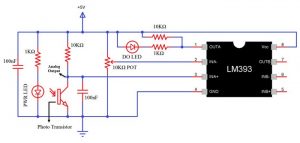What is a Flame Sensor?
A Flame Sensor is a device that can be used to detect presence of a fire source or any other bright light sources. There are several ways to implement a Flame Sensor but the module used in this project is an Infrared Radiation Sensitive Sensor.
A flame-sensor is one kind of detector which is mainly designed for detecting as well as responding to the occurrence of a fire or flame. The flame detection response can depend on its fitting. It includes an alarm system, a natural gas line, propane & a fire suppression system. This sensor is used in industrial boilers. The main function of this is to give authentication whether the boiler is properly working or not. The response of these sensors is faster as well as more accurate compare with a heat/smoke detector because of its mechanism while detecting the flame.
Working Principle
This sensor/detector can be built with an electronic circuit using a receiver like electromagnetic radiation. This sensor uses the infrared flame flash method, which allows the sensor to work through a coating of oil, dust, water vapor, otherwise ice.
This particular flame sensor is based on YG1006 NPN Photo Transistor. The black object at the front of the module is this Photo Transistor.
The YG1006 Photo Transistor looks like a black LED but it is a three terminal NPN Transistor, where the long lead is the Emitter and the shorter one is the collector (there is no base terminal as the light it detects will enable the flow of current).
This photo transistor is coated with black epoxy, making it sensitive to Infrared radiations and this particular Photo Transistor (YG1006) is sensitive to Infrared Radiation in the wavelength range of 760nm to 1100nm.
Using this particular type of Flame Sensor, you can detect Infrared Light up to a distance of 100cm within its 60 degrees of detection angle.
There are two types of implementations of Flame Sensors using YG1006 Photo Transistor: one is with both Analog Output and Digital Output while the other is with only the Digital Output.
Both these implementations require same components but the difference is that one module (the one with the Analog Output) provides the Sensor output as Analog Output.
NOTE: In the circuit diagram of the Flame Sensor, I have pointed out where to get the Analog Output if your module doesn’t have that option.
Components of Flame Sensor Module
The following image shows all the components of a typical Flame Sensor Module.
Circuit Diagram of Flame Sensor Module
If you want to know a little bit more about the Flame Sensor Module, then analyzing its circuit will probably help you. The following image shows the circuit diagram of a Flame Sensor.

Features & Specifications
The features of this sensor include the following.
- Photosensitivity is high
- Response time is fast
- Simple to use
- Sensitivity is adjustable
- Detection angle is 600,
- It is responsive to the flame range.
- Accuracy can be adjustable
- Operating voltage of this sensor is 3.3V to 5V
- Analog voltage o/ps and digital switch o/ps
- The PCB size is 3cm X 1.6cm
- Power indicator & digital switch o/p indicator
- If the flame intensity is lighter within 0.8m then the flame test can be activated, if the flame intensity is high, then the detection of distance will be improved.
Applications
These sensors are used in several dangerous situations which include the following.
- Hydrogen stations
- Industrial heating
- Fire detection
- Fire alarm
- Fire fighting robot
- Drying systems
- Industrial gas turbines
- Domestic heating systems
- Gas-powered cooking devices
Thus, this is all about a flame sensor. From the above information finally, we can conclude that the main purpose of this sensor is to reduce the risks which are associated with the ignition. These sensors respond frequently than a smoke or heat detector.











